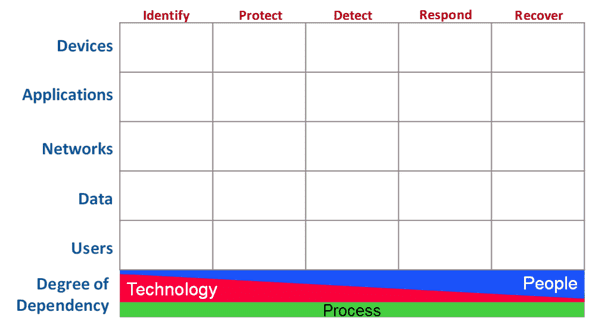What is the OWASP Cyber Defense Matrix?
The OWASP® Foundation works to improve the security of software through its community-led open source software projects, including the OWASP Cyber Defense Matrix, a project initially created to help organize security technologies across the cybersecurity vendor marketplace. They address some of the confusion that still exists as a result of both a cybersecurity community that doesn’t use consistent terminology and vendors who use marketecture language based on trendy jargon.
Let’s first take a peek at an empty Cyber Defense Matrix and then dig into the components that define its structure.
 Source: https://owasp.org/www-project-cyber-defense-matrix/
Source: https://owasp.org/www-project-cyber-defense-matrix/
The raw matrix is structured as a five-by-five grid with the left column labels consisting of Asset Types and the top row labels of Security Functions.
These five high level security functions, described in detail in the Introduction to the NIST Cybersecurity Framework, are listed below for reference:
- Identify (ID) – Develop an organizational understanding to manage cybersecurity risk to systems, people, assets, data, and capabilities.
- Protect (PR) – Develop and implement appropriate safeguards to ensure delivery of critical services.
- Detect (DE) – Develop and implement appropriate activities to identify the occurrence of a cybersecurity event.
- Respond (RS) – Develop and implement appropriate activities to take action regarding a detected cybersecurity incident.
- Recover (RC) – Develop and implement appropriate activities to maintain plans for resilience and to restore any capabilities or services that were impaired due to a cybersecurity incident.
The CIS Controls, in conjunction with the five NIST functions, uses five Asset Types to classify almost every individual CIS Sub-Control.
- Devices
- Applications
- Networks
- Data
- Users
While the image below is an arbitrary example taken from the CIS Controls v7.1 document, it illustrates how CIS Sub-Control 4.1: Maintain Inventory of Administrative Accounts applies to the intersection of the Users asset type and the Detect security function. For a deeper dive on CIS, take a look at our recent blog Understanding CIS Controls and Benchmarks.
Now let’s use the Cyber Defense Matrix as a tool to organize some data pertaining to security controls. As you review the entire set of NIST CSF Subcategories and CIS Sub-Controls totaled by their related security function, Protect receives by far the most attention, followed by Detect and Identify.
- Identify – NIST CSF: 29 / CIS 18
- Protect – NIST CSF: 39 / CIS 75
- Detect – NIST CSF: 18 / CIS 36
- Respond – NIST CSF: 16 / CIS 6
- Recover – NIST CSF: 6 / CIS 0
Going back to the matrix structure, there is a categorization of the People / Process / Technology model represented as a continuum characterizing the Degree of Dependency for each. There is a consistent reliance on Process, a strong dependency on Technology solutions to Identify and Protect, and an increasing need to apply your human expertise (People) as you move into Detect, Respond, and Recover.
When a Security Event occurs related to one of our assets, it happens between the Protect and Detect columns. This highlights the importance of leveraging Technology solutions along with the Identify and Protect functions. However, keep in mind that this is not a one-time effort, but rather an ongoing struggle to keep up with new assets and their ever-changing configurations.
Original version appears on the OpsCompass blog
